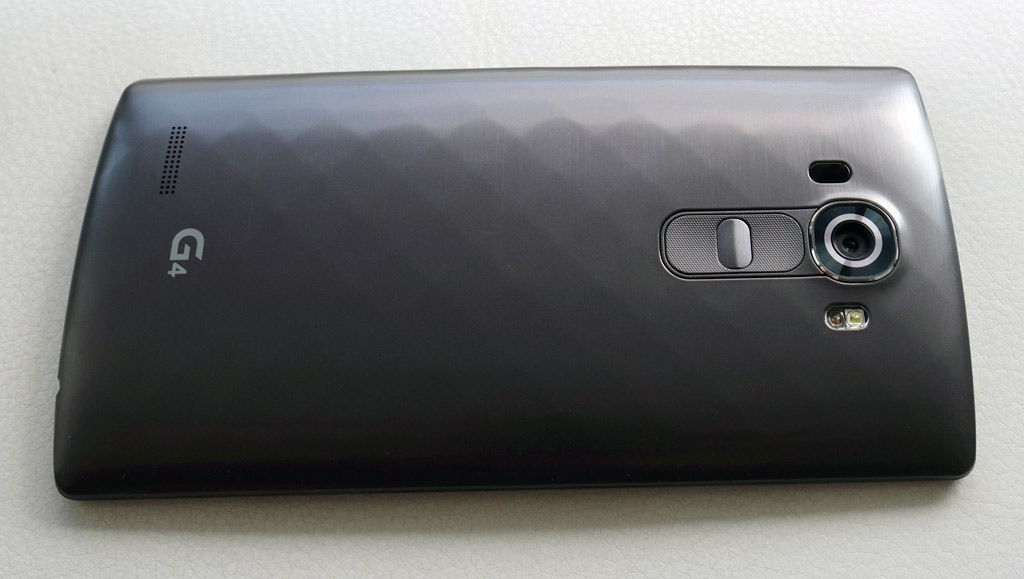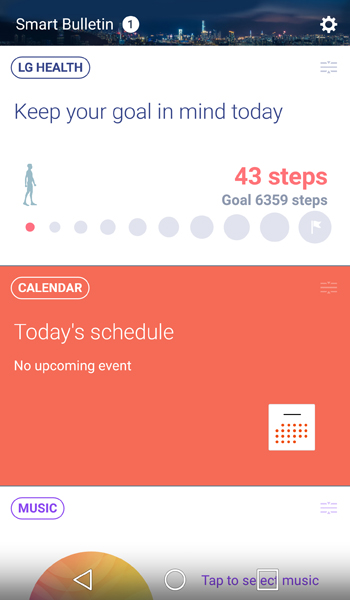
|
Display: 5.5-inch 2560 x 1440 IPS Quad HD display with 538 pixels per inch OS: Android 5.1 Lollipop Processor: 1.8GHz Snapdragon 808 64-bit hexa-core processor Memory: 3GB RAM, 32GB (microSD card slot expandable up to 2TB) Camera: 16-megapixel rear camera with optical image stabilization, 8-megapixel front-facing Video: Up to 4K Ultra HD video recording Battery: 3000mAh (removable) Connections: LTE, Wi-Fi (Wireless-AC), Bluetooth 4.1, NFC, A-GPS Dimensions: 5.86 x 3.00 x 0.39 inches Weight: 155 grams Comes in black, white and gold |
LG has proven that it can manufacture a really good smartphone, much like it already did with devices like the Nexus 5 and G3. Last year’s G3 made considerable improvements on the software side of things, improving the user experience in tangible ways, yet it still didn’t go far enough in standing out from the crowded Android pack. The G4 deviates little from an overall design standpoint, but offers an excellent camera upgrade and simpler software for a compelling contender.
At first glance, it doesn’t look like LG changed much here. The G4 is a little taller and a smidgen wider than its predecessor, easily making room for a slightly larger display than last year. The same design philosophy permeates the device because it doesn’t veer off much from what LG has done before.
Design
The curved contour of the back and placement of the power and volume buttons under the lens are clearly LG staples now. The company seems to like being curvy, and even applied a slight angle onto the G4’s 5.5-inch display itself—something LG calls “Slim Arc”. The display is of particular interest here, only because it’s a noticeable improvement from the G3. LG quantifies this by saying that the G4 has 50% better contrast and 20% better colour reproduction, all of which is hard to argue when comparing the two phones together side-by-side.
The back comes in a few different colours that give the illusion of metal, but are actually plastic and metal compounds, etched with a patterned design to give it a little bit of character. In addition, LG is also using leather. This is full grain leather, the quality of which LG claims is on par with luxury fashion brands, and far more durable than genuine leather. Because the back plate comes off, it’s easy to apply a leather one onto the phone, leading to a number of colour combinations, since there will be a few different leather tones to choose from.
Either way, the back has a 16-megapixel rear camera with optical image stabilization (OIS) 2.0, plus an LED flash and colour spectrum sensor—the latter of which is a first for a smartphone. That plays a big role when shooting photos, which I’ll touch on further down. The power and volume buttons are in their familiar spots, along with the small speaker at the bottom.
Removing the back also means removing the 3000mAh battery, along with the microSIM card slot and microSD slot that is expandable up to a whopping 2TB.
Under the hood, LG opted to go with the Snapdragon 808 hexa-core processor. This won’t really matter if you consider yourself an average user, but tech aficionados may wonder why. Despite not using the seemingly faster Snapdragon 810 chipset, performance is unlikely to seem different to most users.

 Software
Software
LG uses the term “UX 4.0” to describe its software approach with the G4, but that’s just marketing lingo to encompass some of the changes made. Swiping right from the home screen reveals Smart Bulletin, a mix of some of the features LG has included or adapted, like Event Pocket, which is a unifying calendar app that takes appointments and entries from others, including Facebook, and puts them together.
Others are always noticeable, like Smart Notice, the ticker that appears below the weather widget. This is meant to be personalized and contextual over time, learning your habits and adapting its messaging and alerts to your usage. It’s a nice idea, except it seems to take time to actually seem personal. I appreciated it telling me that Spotify—an app I use often—would take up a certain percentage of battery life, but I can’t say that it made an impact after about a month of usage.
LG tweaked its software, rather than overhauled it. App icons are flatter, Settings is now easier to navigate, and the drop-down notifications pane is far less messy than it was in the past. KnockOn, the feature that wakes up the phone by double-tapping the display, is back, as is LG Health, which I’m still not particularly sold on. The real improvement here is basic navigation and overall usage. Everything seems a little more laid back.
Performance
When there’s fluid performance on the software side, it’s usually a good sign that it’s like that across the board. I had no real issue doing anything I would normally do on a smartphone, whether it was making calls, streaming video, streaming music or playing games. It zipped through everything speedily, never really showing me any lag or sluggishness along the way.
The one gripe I have about the G4’s performance is the rear speaker. It simply doesn’t sound as good as other competitors, and is the one weak link for the device. The curved back does help sound escape when the phone is resting on its back on a flat surface, but even at full volume, it doesn’t sound loud enough.

Camera
If there is a flagship feature for the G4, this is it. LG attempted to greatly expand on what it did last year, while also trying to stand out from the crowd. The 16-megapixel image sensor isn’t so much the standout, it’s the wider f/1.8 aperture, OIS 2.0 and colour spectrum sensor that work some magic here. The spectrum sensor measures the ambient light from both the source and where objects are reflected in the scene, while the wider aperture allows more light to come in through the lens to the image sensor.
These features combine for some of the best performance available on a smartphone. There aren’t a lot of modes to shoot with, which doesn’t matter in the grander scheme, because you will utilize Auto, HDR and Manual the most. Manual is my personal favourite. Admittedly, having experience as a photographer helped get acclimated to it quickly, but it’s been designed in such a way that even novices can understand what’s happening.
The reason why is because toggling the settings for shutter speed, ISO, white balance and exposure yields real-time results. Adjust them and you see what your photo will look like. The focusing is superb and lightning fast, while low-light shots are also excellent.
Budding photographers will love that it can also shoot in RAW format. It even shoots both RAW and JPEG at the same time. And shooting 4K video clips is also possible, though they can take up a lot of the phone’s internal storage if they pile up.
Battery life
The G4 doesn’t have exceptional battery life, so don’t expect to last longer than others. That’s not to say that it’s bad, only that it’s pretty ordinary. Having a brighter display with that many pixels, on top of all the features the phone offers, seems to sap life from it a little faster than the way the G3’s battery performs.
The fact the G4 has a removable battery will be a benefit to those who like the idea of swapping them out. That’s a small consolation for those who don’t care, but either way, that is always an option.
Final Thoughts
This is easily the best smartphone LG has ever put together, and it’s the camera that really makes it so unique to use. The software tweaks, excellent display and overall design make the G4 a viable handset to choose from, and since it shoots great photos, it offers solid versatility. There is room for improvement in some areas, but at least LG took a thoughtful approach and didn’t try to pack in more than it needed to.
Best Buy will be carrying the LG G4 soon, and you can check out LG’s current lineup of phones here.



